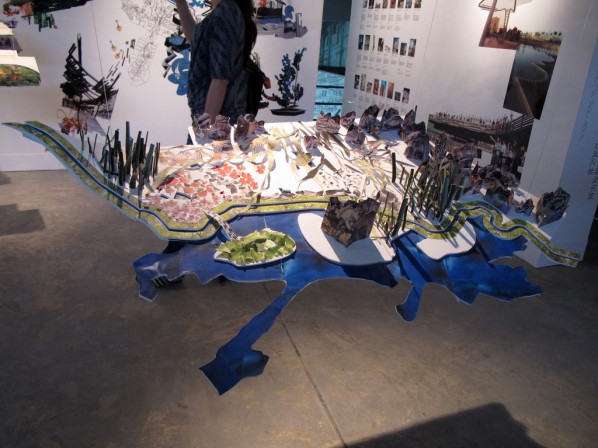
Holistic Realm: International Architecture Exhibition 01;Photo: Julie/ CAFA ART INFO
Through the staging of its contemporary displays, the 2011 Chengdu Biennale highlights Chengdu’s efforts to transform itself into a “Modern International Garden City”. The overarching leitmotif of the garden city indicates two interrelated aspects: one material, the other spiritual. The Englishman Ebenezer Howard (1850-1920) expressed the following desire in his Garden Cities of Tomorrow: “Shall we be able to build up a society with art and culture for all, and with some great spiritual aim dominating people’s lives?”
A “garden city” was not simply an urban form, but the embodiment of a desire that this ideal city would be controlled by the spirit. This is in complete accord with the ancient Chinese philosophy based on harmony between heaven and man. In the chapter of The Literary Mind and the Carving of Dragons titled “Material colouring” (wù sè), Liu Xie wrote of the artist “turning”, flowing”, and “mentally hovering” within the changes of matter and of vistas, and this expressed his creative view of the complementarity of matter and spirit. “Garden cities” insist that we observe not only the spatiotemporal changes a city undergoes but that we also see how within concepts, as within material objects, clear distinctions exist, and these can provide ideas with material forms so that what exists without occupying space serves at the same time to explain space. Moreover, these two forms of space have interactive elements that suffuse within a specific duration, such as Bergson indicated. In post-modern cultural theory, the unseen layered changes of duration are more surprising than any of the surface changes that can be observed.

The Entrance of Holistic Realm-International Architecture Exhibition 02

Holistic Realm: International Architecture Exhibition 03;Photo: Julie/ CAFA ART INFO

Holistic Realm: International Architecture Exhibition 04;Photo: Julie/ CAFA ART INFO
The dominant and overall theme of the 2011 Chengdu Biennale, “Changing Vistas: Creative Duration”, is intended to express how the garden city represents visible spatial change while duration indicates those spatially invisible layers of culture and art which play such a basic role within urban space. At the same time, the changing vistas with “material colouring” denote the response in the human consciousness to the “garden city”; in this context “duration” indicates the immediate and present existence of the traditional notion of what was past. Indeed, the changing vistas indicated by “material colouring” highlight an ancient Chinese concept that matches the architectural notions of “future space” (architecture in the garden city) and the design exhibition’s “way (dao) of strategic resolution”; “duration” occupies an important position in modern art theory, as well as quietly resonating with the thinking behind the eternal pure landscapes presented around the theme of “pure views”, fully translatable as “pure and remote streams and mountains”. An ancient Chinese concept thereby finds its echoes in a modern Western concept, and it is fitting that this conceptual fusion provides the theme for the 2001 Chengdu Biennale, as well as an annotation and response to Chengdu’s own ambitious “garden city” project.

Holistic Realm: International Architecture Exhibition 05

Holistic Realm: International Architecture Exhibition 06

Holistic Realm: International Architecture Exhibition 07

Holistic Realm: International Architecture Exhibition 08;Photo: Julie/ CAFA ART INFO
Holistic Realm: International Architecture Exhibition
Curator: Zhi Wenjun
Duration: 29th September – 30th October 2011
Venue: Chengdu Industrial Civilization Museum
Contents of Exhibitions:
Four platforms, namely Holistic Realm: Gardens/Cities/Architecture, theme exhibition; Holistic Realm: Gardens/Cities/Architecture, documenta; City Development Cup Competitive Show featuring the design work of tertiary student; and Gardens/Cities/Architecture: Chengdu Creative Industries Architectural Design Exhibition. Assessment of the student entries will be conducted by a judging panel comprising prominent international and Chinese architects and designers.
“Garden City:The Original and Its Development till Now” is a documental exhibition of the “Holistic Realm”international architecture exhibition. It contains five parts: Part One, “Garden” + “City”: Past Visions, describes the expectation of human settlement in ancient literature and art of Western and China. Part Two, “Garden City: theory and its practice”, displays the major content of Ebenezer Howard’s Garden City theory and achievement of Garden City Movement in early 20th century. Part Three, “Evolution and Extension”, exhibits the achievements of modern urban planning under the subjects Howard proposed: “structuring urban system”, “building city in garden”, “introducing rural beauty into city” and “reconstituting inner environment of city”. Part Four, “new synthesis and advancement”, reviews the Garden City theory and its ideas according to the principles of sustainable development. Part Five, a chronological table of the development and evolution of the idea of Garden City since 1898.

Holistic Realm: International Architecture Exhibition 09;Photo: Julie/ CAFA ART INFO

Holistic Realm: International Architecture Exhibition 10;Photo: Julie/ CAFA ART INFO

Holistic Realm: International Architecture Exhibition 11;Photo: Julie/ CAFA ART INFO

Holistic Realm: International Architecture Exhibition 12;Photo: Julie/ CAFA ART INFO

Holistic Realm: International Architecture Exhibition 13;Photo: Julie/ CAFA ART INFO

Holistic Realm: International Architecture Exhibition 14;Photo: Julie/ CAFA ART INFO

Small Library Bar at the Holistic Realm: International Architecture Exhibition




























